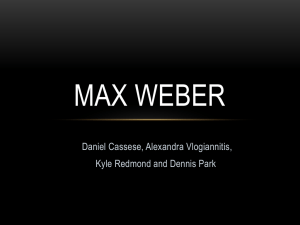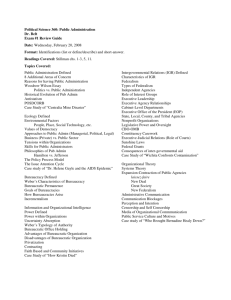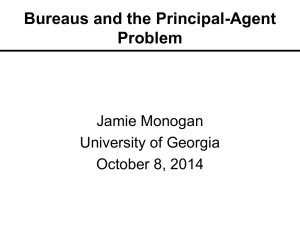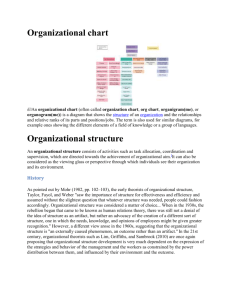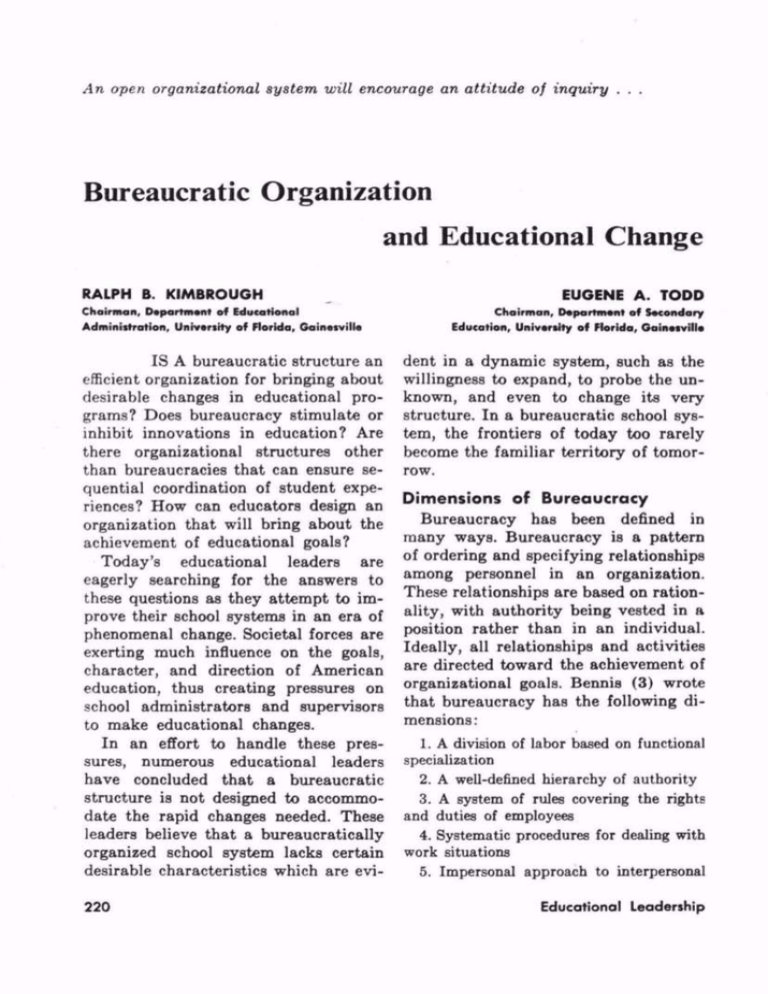
An open organizational system will encourage an attitude of inquiry . . .
Bureaucratic Organization
and Educational Change
RALPH B. KIMBROUGH
Chairman, Dtpartimnt of Educational
Administration, University of Florida, Gainnville
IS A bureaucratic structure an
efficient organization for bringing about
desirable changes in educational pro
grams? Does bureaucracy stimulate or
inhibit innovations in education? Are
there organizational structures other
than bureaucracies that can ensure se
quential coordination of student expe
riences? How can educators design an
organization that will bring about the
achievement of educational goals?
Today's educational leaders are
eagerly searching for the answers to
these questions as they attempt to im
prove their school systems in an era of
phenomenal change. Societal forces are
exerting much influence on the goals,
character, and direction of American
education, thus creating pressures on
school administrators and supervisors
to make educational changes.
In an effort to handle these pres
sures, numerous educational leaders
have concluded that a bureaucratic
structure is not designed to accommo
date the rapid changes needed. These
leaders believe that a bureaucratically
organized school system lacks certain
desirable characteristics which are evi220
EUGENE A. TODD
Chairman, O*partm*nt of Secondary
Education, UnivoraJty of Florida, Gainotvillo
dent in a dynamic system, such as the
willingness to expand, to probe the un
known, and even to change its very
structure. In a bureaucratic school sys
tem, the frontiers of today too rarely
become the familiar territory of tomor
row.
Dimensions of Bureaucracy
Bureaucracy has been defined in
many ways. Bureaucracy is a pattern
of ordering and specifying relationships
among personnel in an organization.
These relationships are based on ration
ality, with authority being vested in a
position rather than in an individual.
Ideally, all relationships and activities
are directed toward the achievement of
organizational goals. Bennis (3) wrote
that bureaucracy has the following di
mensions:
1. A division of labor based on functional
specialization
2. A well-defined hierarchy of authority
3. A system of rules covering the rights
and duties of employees
4. Systematic procedures for dealing with
work situations
5. Impersonal approach to interpersonal
Educational Leadership
relations and the promotion of rational be
havior according to organizational goals
6. Promotion and selection based on tech
nical competence.
In the typical bureaucratic organiza
tion, importance is placed upon achiev
ing unity of command. Control of pro
grams through attention to gradation
of authority is emphasized. The grada
tions of authority are usually reflected
in the differentiation in salaries from
top to bottom.
School systems develop specific rules
of procedures which are legitimatized
by the force of specialized knowledge
and weight of hierarchical authority
built into the system. These rules are
designed to encourage rational behav
ior that behavior expected in achiev
ing the goals often predetermined with
in the hierarchy. Irrational behavior in
the form of student or faculty cliques
(informal organizations) is neither ex
pected nor condoned in theory. The
division of labor along lines of speciali
zation, combined with hierarchical de
scriptions of authority, produces for
midable organizational machinery in
school systems.
In addition to the dimensions listed
above, four necessary dimensions
unique to educational organizations
follow:
tween hierarchical authority and pro
fessional specialization, school systems
have attempted to grant autonomy to
the teacher as a professional to make
discretionary judgments about proce
dures to be used during the time a stu
dent group is in his charge. Studies have
shown, however, that bureaucratization
tends to result in the lessening of auton
omy for teachers as school districts
grow in size.
3. Dual responsibilities. Unlike some
other organizations, the public schools
have a responsibility to a student clien
tele and a responsibility to a public
constituency. In most professional and
business organizations, responsibility is
centered upon one clientele.
4. Guaranteed existence. Legislation
at the local, state, and federal levels
guarantees the continued existence of
public school systems. As a result, inno
vation may be less likely to be intro
duced because the need to change has
not been a requirement for organiza
tional survival. The students have to
attend and the schools have to serve.
Most students of organizations be
lieve that the dimensions of bureauc
racy described above have to be either
modified or eliminated if the organiza
tions of the future are to become inno
vative organizations. One or more of
1. Sequential coordination of student the following criticisms of bureaucracy
experiences. Since students progress appear in many recent articles and
through twelve or more grades in dif books written about organizations:
ferent schools and at different levels,
1. The inability to legitimize differences in
school systems have traditionally at
among personnel depresses creativity.
ideas
tempted to ensure a sequential coordi
probability exists that new ideas
The
2.
nation through bureaucratization of
generated from within will be subjected to
content and methodology.
vetoes by members of the official hierarchy,
2. Teacher autonomy. In attempting especially if these ideas are in conflict with
to minimize the inherent conflict be perceived rational teaching behavior.
December 1967
221
3. Bureaucracy does not adequately allow
for personal growth and the development of
mature and healthy personalities.
4. The bureaucratic organization does not
have an adequate structure and process for
the review of decisions.
5. The bureaucratic structure cannot ac
commodate the diversity of external inputs
needed for a democratic school system.
6. The extrinsic reward system stimulates
conformity rather than innovation.
7. The prior commitments of organiza
tional resources to subunits within the or
ganization make it difficult to develop in
novative solutions for new problems.
8. Bureaucracy does not take into account
the "informal organization."
9. The lines of communication are often
times closed because of hierarchical divi
sions.
thorities contend that the bureaucratic
structure assures orderly, efficient edu
cational change.
Toward Innovative Organization
The writers believe that the ques
tions posed in the opening paragraph
cannot be answered with unqualified
"Yeses" or "Nos." We would contend
that bureaucracy is not all bad and that
some features in an altered form may
be retained. Such features as (a) the
commitment to the achievement of or
ganizational goals and (b) the system
of rules covering the rights and duties
of employees have merit and legiti
mately belong in educational organiza
tions. Nevertheless, we feel that the
time has come for educational leaders
to make alterations in their bureau
Needless to say, the bureaucratic or
cratic structures or to create new sys
ganization does not go undefended tems if their organizations are to be
against criticism. For instance, some come innovative. In initiating organi
writers contend that the faults found in zational changes, educators should give
bureaucracy lie in the mismanagement consideration to the propositions re
of the organization rather than in the viewed in the following paragraphs.
description of qualities inherent in the
The organization should have an ef
structure. Instead of being undemo
fective system for planning programs
cratic, bureaucracy is presented by its which provide educational opportunities
advocates as a form of democracy in for all students. Educational change is
that it enables schoolmen to organize thwarted by a lack of planning. As a
for goal fulfillment and meet the educa
consequence of ineffective planning,
tional needs of a school district.
much organizational energy is wasted
According to its advocates, leader
in attempts to serve disparate, poorly
ship in a bureaucracy is position ori
defined goals. Planning in the tradi
ented, thus the irrational behavior of tional bureaucratic organization is an
minority cliques is effectively con
elite process, often resulting in harmful
trolled. These authorities also contend conflict and in apathy toward the sug
that critics of the bureaucratic system gested goals. The traditional organiza
have failed to provide the concrete di
tion is often more concerned with pro
mensions for a replacement organiza
duction than with what should be pro
duced. Therefore, identification with
tion. They ask, for example, what alter
natives to the division of labor along educational needs is often lost in orga
nizational management; children have
specialization lines exist. These au
222
Educational Leadership
served organizational needs more than
their educational needs have been
served. We believe that organizational
arrangements should be made for effec
tive planning of educational programs
and that this planning should be made
upon educational needs rather than
upon artificial organizational needs.
Organizational machinery should be
established to encourage effective com
munication for continuing development
and clarification of a system of educa
tional ideas which has relevance for
practice. The educational ideas provide
for system unification. Measurement
and evaluation of organizational deci
sions are based upon the educational
ideology. An essential factor of any
school system operation is the neces
sity of ensuring sequential coordination
of student experiences. Measurement
and evaluation of decisions in terms of
the relevant system of ideas will help
provide the base for the sequential co
ordination of student experiences. Fur
thermore, this will help assure the at
tainment of organizational goals. The
authors emphasize, however, that com
munication concerning "What we are
about" is a continuous process. Conse
quently, the ideas to which the system
is committed are undergoing continu
ous development, clarification, and
change.
Pluralism and collegia! relations in
decision making concerning educational
processes should characterize the mod
ern educational organization. Numer
ous authorities have pointed to the
need to establish systematic arrange
ments for teacher participation in orga
nizational decision making. The bureau
cratic organization is inherently in
conflict with this objective. As a conse
December 1967
quence, teachers are forcing negotiation
agreements. In the collegia! type orga
nization, specific arrangements are
made for cooperative participation in
policy making. School systems should
achieve maximum utilization of group
processes. An analysis of current lead
ership research indicates that admini
strators and supervisors are more effec
tive when they help groups to define
and achieve their tasks, goals, and pur
poses.
Administrative activities should be
dispersed and decentralized down to the
level of the innovative area whenever
possible. If school systems are to have
the active participation of the profes
sional staff in the change process, the
staff must be permitted to introduce
innovations at their levels. This right
reduces the threat of vetoes now pres
ent in bureaucratic organizations. The
traditional bureaucratic organization
was designed to reduce conflict and fo
cus administrative activity around pre
determined goals. We would suggest
that the modern organization should be
flexible enough to legitimatize conflict
which is not destructive. Constructive
conflict generates a variety of alterna
tive solutions. Thus, school systems can
select from a variety of solutions in
stead of being forced to accept one solu
tion. This encourages the development
of a pluralistic social system.
School systems should establish an
environment in which the "search for
truth" can flourish from the individual
classroom to the meeting room of the
Board of Education. School personnel
should be encouraged to search for bet
ter ways of doing things. Such a search
will mean a critical analysis of present
practices. An open organizational sys223
tern will encourage an attitude of in
quiry. The "search for truth" also im
plies the right to experiment and its
concomitant result the right to fail.
Experimentation should be legitima
tized.
School systems organized for educa
tional change should develop a harmo
nious balance between the achievement
of personal goals and institutional
goals. Several writers have observed
that the traditional monocratic organi
zation tends to emphasize organiza
tional goals that are in conflict with the
personal need dispositions of school per
sonnel. The organization should be sen
sitive to and responsive to the need
dispositions of personnel.
The organization should provide for
the effective participation of school
leaders in the external social systems.
The school system does not exist in a
political and social vacuum. It is a sub
system of the community power system
and of the state and national systems.
Desirable changes in education often
fail because the educational organiza
tion did not provide for effective action
in politics. Professional personnel at all
levels must be knowledgeable about the
"politics of education" and at appro
priate times function as political acti
vists. Openness to change in school
organizations is conditioned by the de
gree of openness and closedness in the
political power systems within which
school systems operate.
References
1. Chris Argyria. Organization and Innova
tion. Homewood, Illinois: Richard D. Irwin,
Inc., 1965.
2. W. G. Bennia, K. D. Benne, and R. Chin,
editors. The Planning of Change. New York:
Holt, Rinehart and Winston, Inc., 1961.
224
3. W. G. Bennis. Changing Organizations.
New York: McGraw-Hill Book Company.
Inc., 1966.
4. George Homans. Social Behavior: Its
Elementary Forms. New York: Harcourt.
Brace & World, Inc., 1961.
5. John G. Hutchinson. Organizations:
Theory and Classical Concepts. New York:
Holt, Rinehart and Winston, Inc., 1967.
6. Robert L. Kahn and others. Organiza
tional Stress: Studies in Role Conflict and
Ambiguity. New York: John Wiley & Sons.
Inc., 1964.
7. Ralph B. Kimbrough. Political Power
and Educational Decision-making. Chicago:
Rand McNally & Company, 1964.
8. J. G. March, editor. Handbook of Orga
nizations. Chicago: Rand McNally & Com
pany, 1965.
9. Matthew B. Miles, editor. Innovations in
Education. New York: Bureau of Publica
tions, Teachers College, Columbia University.
1964.
10. E. L. Morphet, R. L. Johns, and T. L.
Reller. Educational Organization and Admin
istration. (Second edition.) Englewood Cliffs.
New Jersey: Prentice-Hall, Inc., 1967.
11. A. H. Rubenstein and C. J. Haverstrob,
editors. Some Theories of Organization. ( Re
vised edition.) Homewood, Illinois: Richard
D. Irwin, Inc., 1966.
12. James D. Thompson, editor. Approaches
to Organizational Design. Pittsburgh: Univer
sity of Pittsburgh Press, 1966.
13. Victor B. Thompson. "Bureaucracy and
Innovation." Administrative Science Quar
terly 10 (1): 1-20; June 1965.
14. Eugene A. Todd. The Administration of
Change: A Study of Administrative Tenure.
Houston, Texas: Bureau of Educational Re
search and Service, University of Houston.
1963.
15. Eugene A. Todd. "Organizing School
Districts for Purposeful Change." A paper
presented at the annual meeting of The
Southern Regional Council on Educational
Administration, Atlanta, Georgia, November
14, 1966.
16. Kimball Wiles. Supervision for Better
Schools. ( Third edition.) Englewood Cliffs,
New Jersey: Prentice-Hall, Inc., 1967.
-£%
Educational Leadership
Copyright © 1967 by the Association for Supervision and Curriculum
Development. All rights reserved.


